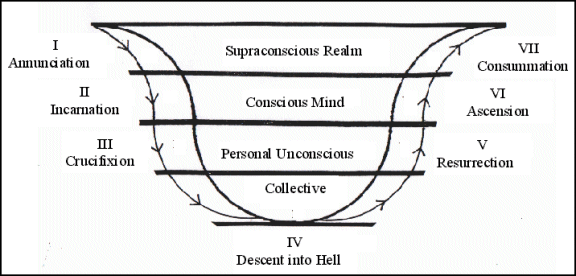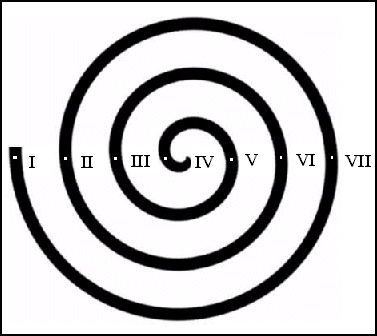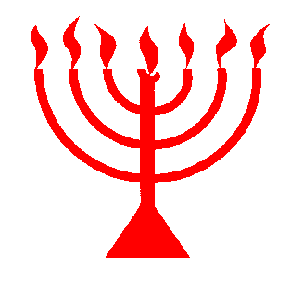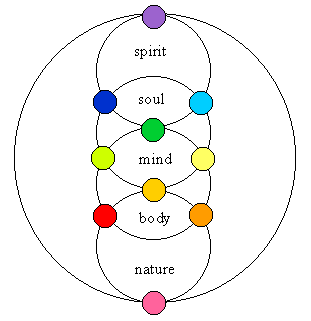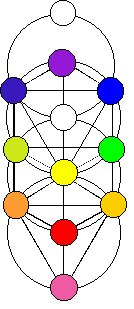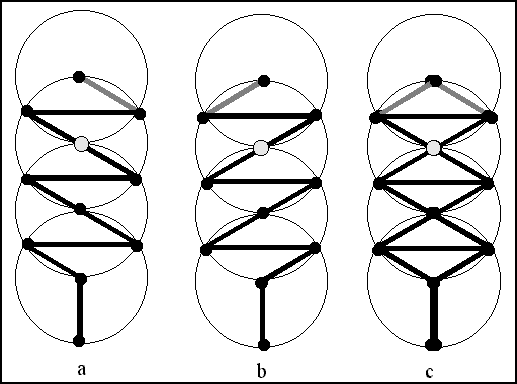|
THE
LIFE OF CHRIST
|
The drama of the archetypal life of Christ describes
in symbolic images the events in the conscious life
--as well as in the life that transcends consciousness--
of a man [or woman] who has been transformed
by his [or her] higher destiny. C G Jung
1
I
STEPPING STONES TO HIGHER CONSCIOUSNESS
The Ancient Mysteries
An ancient way of envisioning the soul’s journey was in progressive stages through descending and ascending levels of consciousness. The purpose of some of the world’s most ancient teachings was to guide neophytes safely through these stages. Until as recently as the twentieth century, knowledge of this process was considered sacred and limited to word-of-mouth transmission supported by geometric and diagrammatic constructs, with the journey itself requiring careful preparation and close supervision.
As if hiding in plain view, the stages of the soul’s progression towards union with God is contained in the stepping-stone events of the life of Christ. This progression would inspire the magnum opus of the medieval philosopher-alchemists, whose work in turn would lead Jung to discover the parallel pattern of events in the individuation process of depth psychology.
The quote at
the beginning of this chapter suggests that a person is transformed by his
or her higher destiny, and that the self-discovery to which persons are
called requires each to follow where the inner voice of Self leads with the
same faithfulness as Jesus. “In every feature,” Jung writes,
Christ’s life is a prototype of individuation and hence cannot be imitated: one can only live one’s own life totally in the same way [Christ lived his and] with all the consequences this entails.2
A Framework for the Process
Recent mind/brain research suggests the ancient mysteries were transmitted by modes of perception that engaged the visual and intuitive functions of the right hemisphere of the brain. Diagrammatic images and glyphs (as in hieroglyphics) were effective means of doing this--of engaging the mind in a symbolic mode of perception that increased receptivity to the transforming light contained within the mysteries. Through an expanded and encompassing scope of mind, perception of the interconnection between all things is heightened. As the mystic’s goal is unitive consciousness, this also may have been so for those participating in the ancient mysteries.
Central to how sacred teachings are transmitted is some sort of framework onto which the stages of the process can be ordered. Here again, the main events in the life of Christ fit onto such a framework and correspond remarkably to the archetypal themes of other religions concerning the transformation of consciousness. The ordering structure is sometimes a ladder, or a spiral stairway, musical scale, the rainbow spectrum, or some other gradation that marks movement between higher and lower levels of consciousness. The prime example is Jacob’s ladder upon which he sees angels descending and ascending between heaven and earth.
The benefit of such a framework is the ease with which the systematic symbolism of different cultures, religions and ages can be seen to correspond to one another, and thus bear witness to the one truth under girding the different paths to God. The importance of this for our times is the hope it offers that the many peoples of the one God will come to a realization of their unity.

Figure 1a
Astrological Glyph
for Pisces
The Annals of Time
Besides the “Who am I?” and “Why am I here?” inquiries into one’s higher personal destiny, there are also the “we” questions: “Where in the annals of time are we?” “What stage of our collective human destiny is presently unfolding?” “How do our self-reflective, personal lives serve the higher collective destiny of humanity?”
For as far back as can be pieced together from the remnants of human history, the starry heavens have been the screen onto which the archetypal images of the collective unconscious have been projected. Similar to how the psychological mechanism of projection works from the personal unconscious onto a person, group or situation, so the ancient sky-seers projected images from the collective unconscious onto groups of stars in the heavens. The outlines of the images they saw in the stars were projections from the archetypal psyche in much the same way as dream symbols are. And as projections from the unconscious they were similar to what persons can see in others but not in themselves, except they withdraw their projections and re-examine them for self-revelation. Thus the wisdom of the stars is in the reflection they afford into the archetypal depths of human nature. And now as then, the wise are those who are able to use their projections to gain insight into the “big picture” of human consciousness, and how, like in the heavens, certain patterns appear and reappear cyclically.
When the forefathers of the Hebrews migrated to Canaan they brought with them the ancient Mesopotamian sky-seers’ division of the heavens into twelve “houses.” Each of the twelve sons, who would become the twelve tribes, was assigned one division of the heavens. And since the axis of earth has a slight wobble that causes it to make an elliptical rotation once in approximately 26,000 years, the view from the polar axis shifts every 2,000 or so years from one heavenly stage to the next. With this shift the glyph by which an age is know changes to the one for the next aeon. Because these glyphs have remained basically unchanged for thousands of years, they have passed the test of being true symbols rather than mere signs. They therefore are the actual carriers of the forces they symbolize. As rotationally-changing motifs, they also contain clues to changing collective patterns. And for this reason the glyph for the age now beginning offers hope.
As the Pisces sign of two fishes swimming in opposite directions (Figure 1a) was a reflection of the conflict and division that marked and scarred the past two millennia, so the coherent “air waves” of Aquarius (Figure 1b) promise a time of accord.

Figure 1b
Astrological Glyph for Aquarius
Also encouraging is the new symbolic theme of the heavenly water carrier who, as the Cosmic Christ is pouring out the water of Spirit onto all “flesh.” And incidental to this changeover of symbolic dominants, the entire planet finds itself reduced to the proximity of life in a tribal village, and where the activities of everyone are known to everyone else. As if overnight, the Aquarian air waves are as alive with movement as the Piscean seas once were.
Who could have anticipated the acceleration of activity by which the air waves surrounding planet earth would become such a closely woven net of global interconnections? And now science is surmising what tribal peoples and visionaries have always known: that space is not “empty.” Nor on earth are there any more hidden places, or any more secret mysteries, as from East to West the saced teachings are all “out there” for any who would to access.
Opening to the Light
But accessing the mysteries is not the same as implementing them in one’s life. Receptivity to their light in a way that leads to individual transformation is still what counts.
The mysticism of the ancient Hebrews teaches that there is a house in the back of the head that contains a window through which the light of God can enter. The Kabbalah is said to open this window. Spelled QBLH, each Hebrew letter is also an image: Q is “back of the head”; B is “house”; L is “ox goad”; and H is “window.” Thus the purpose of the Kabbalah is to goad the window housed in the back of the head into opening. What could this mean in terms of the different ways the brain is known to function?
What is now known is that the left hemisphere of the brain controls verbal, logical, linear, sequential, analytical thinking processes, while the right hemisphere is analogical. Its finely-tuned perception is visual, intuitive, musical. Moreover, it perceives wholistically and simultaneously. It expands an idea or concept “into an immense interconnected thought-field” in which “multiple simultaneous meanings” fall into place and are “inwardly felt.” How the two modes differ is superbly explained by Robert and Deborah Lawlor in their Preface to Egyptian scholar Schwaller de Lubicz’s Symbol and the Symbolic3 With underlines, notes and turned-down corners on nearly every page, I have all but destroyed my copy of this slim little volume. The following is an example:
The symbolic attitude of ancient knowledge cultivated the intellect to the extent of perceiving all of the phenomena of nature itself as a symbolic writing revealing the forces and laws governing the energetic and even spiritual aspects of our universe.
Modern science, particularly subatomic physics, has . . . expanded its knowledge of matter to the point where Nature must be considered supra-rational (as being beyond the limits of rational methods and formulae). These new discoveries and ideas . . . demand a new and as yet unfound vocabulary, as well as a radically different approach to education and knowledge itself.4
From the above it can be surmised that what really was being taught in the mystery schools was how to use the right or analogical side of the brain, a mode that utilizes myth, metaphor and analogy, a mode that “connects the dots” and pieces together a felt perception of the whole. It is this mode that gives access to the higher octaves of truth, harmony and proportion, and brings knowledge of the laws of the universe down into individual creative expression. In Blake’s words, it is
To see a world in a grain of sand
And a heaven in a wild flower,
Hold infinity in the palm of your hand
And eternity in an hour. 5
Tapping into Deeper Levels
Evidence also suggests that in some case those being initiated into the mysteries were guided through a prolonged and deliberate process by which inner fears and other hidden, unconscious contents were exteriorized in order to be confronted and overcome. In much this same way the early Christian “Desert Fathers” succeeded in ridding themselves of the inner demons of their unconscious minds by subjecting themselves to aesthetic spiritual practices in combination with extreme sensory depravation. As a result of this emptying of the personal unconscious, they tapped into the deeper levels of the psyche. The “signs and wonders” that followed were recorded in the accounts of their lives, as well as in the lives of other saints--from both East and West--whose inner transformation was followed by supra and paranormal powers.
Jung, in his lifework, would discover the principles of depth psychology as fully operational in the spiritual disciplines and practices of the past. What he and others in the new field of psychology would provide was a language--a terminology--through which the laws of the psyche could be widely understood and disseminated.
Christianity as a Mystery Religion
Some believe that Christianity in its purest form, and as transmitted in the Gospel of John, was a mystery school with similarities to those of ancient Egypt and Greece. If so, then its teachings were not intended to be grasped through rational, logical, literal-minded, analytical thinking. Rather, its deeper teachings were hidden within its symbolism and in the person of Jesus--not just his words but his every move and manner. If so, then the mysteries of his life were meant to be received in way that allowed them to expand “into an immense interconnected thought-field” of “multiple simultaneous meanings.” Received in this way, the light of God found entry through the window of the spiritual mind.
A succinct summary of the pivotal events marking the life of Christ, the same events that would become the Christian mysteries, are outlined in the Apostles’ Creed.
He was
conceived . . . by the Holy Spirit
. . . born of the Virgin Mary.
. . . suffered under Pontius Pilate,
was crucified, died, and was buried.
He descended to the dead.
On the third day he rose again.
He ascended into heaven,
and is seated at the right hand of the Father.
The above enumerated events are those celebrated as Christianity’s “high holy days.” They are also the “holy mysteries” contemplated by millions of ordinary Christians who daily pray the liturgy of the Rosary, not in churches but wherever they are, as with beads and imagination they move from the joyous anticipation of Christ’s coming, to the sorrow of the Crucifixion, the glory of the Resurrection, and his consummate return to the heavens.
In addition, the creed speaks of how the inner Christ is conceived, born of the spirit, and its new life nurtured to maturity. But the soul, on its journey, also suffers crucifixion and descends into the lower regions of the unconscious until, at the lowest point, the way down becomes the way up that leads to its rebirth and ascension to new transcendent heights. In Psychology and Religion Jung writes:
[A creed is] always the result and fruit of many minds and many centuries, purified from all the oddities, shortcomings and flaws of individual experience.6
To the above he adds that “to a seeker after truth” a creed is nevertheless not as convincing as a “warm red blood pulsating” personal experience. He also points out that creeds and dogma sometime serve to protect and even insulate persons from a direct encounter with the divine and the demands such a breakthrough makes on a person’s life.7
II
THE JOURNEY THROUGH FOUR LEVELS
IN SEVEN STAGES
The Annunciation-to-Consummation Cycle
In Figure
2 below, the Annunciation-to-Consummation cycle is diagrammed with the
descent and the returning ascent moving through the four levels into which
the span of human consciousness ordinarily is divided: (1) the supra or
transcendent realm of consciousness; (2) the level of the ordinary, everyday
conscious mind; (3) the personal unconscious; and (4) the collective or
archetypal level.
